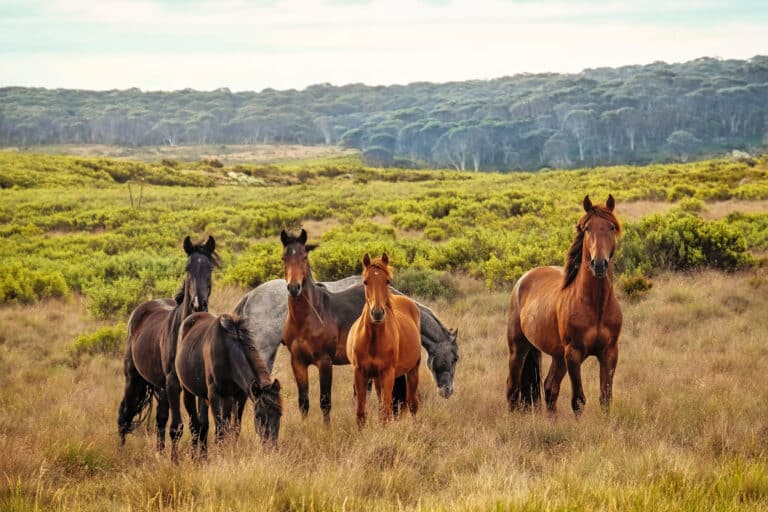The Australian Heritage Brumby is unique. They are able not only survive but thrive in the harshest of conditions, writes MATHILDE GREGOIRE.
Brumbies are an integral part of Australia’s culture and history. They’ve been featured in many novels, appeared in movies such as The Silver Brumby and, unforgettably, The Man from Snowy River. They were also the subject of The Man from Coxs River, a documentary film on saving a mob of wild Brumbies. Sadly, the iconic Brumby, acclaimed for their versatility and hardiness, are today subject to much controversy over their growing numbers in the wild.
From the beginning
There are no indigenous horses of Australia – the first horses to be introduced to the continent dates back to the 18th century. Following their loss of the American colonies in 1783, the British Government sent a fleet of ships, now known as the First Fleet, to establish a new penal colony in NSW in 1788. These ships, along with later expeditions, carried various breeds of horses, including Thoroughbreds, Arabians, and even draft horses.
The horses were destined for agricultural and utility work, and Brumbies are descendants of the domesticated horses that were subsequently released into the wild. It is said they were named after Sergeant James Brumby, an early settler who left his horses to free range in NSW following his departure for Tasmania in 1804. Over the past 200 years, they have been roaming freely and have adapted to Australia’s harsh climate.
Known for hardiness
The horses that made it to Australia were the most robust. Having survived a long journey at sea, they had proved their hardiness and ability to survive. Once some of these horses and their off spring became feral, natural selection took over and yielded a resilient breed, able to survive in the harsh Australian climate with its often extreme conditions.
Since Brumbies aren’t from a specific breed but rather a group of various breeds released into the wild, there is no specific size or coat colour, and characteristics can differ greatly from one mob to the next. The most common colors are black and bay, but piebald, grey, and palomino are not unknown. They also vary significantly instature, ranging from 13hh to 15hh, and are surefooted with hard hooves and strong bones. Captured Brumbies can be trained as stock and other saddle horses, and they excel at trail riding. Wild Brumbies have also been used in camps for troubled, at risk youths, who train them to become quiet, willing saddle horses, improving their own self-esteem in the process.

Brumbies not only survive but thrive in outback Australia (Image courtesy of Kings Creek Station).
Brumbies today
Today, Brumbies are found mostly in the NSW Alps region, as well as the Northern Territory and Queensland. Perhaps some of the best known are located in the Kosciuszko National Park in NSW, the mountainous area which inspired Andrew Barton (Banjo) Paterson’s famous poem The Man from Snowy River. Their name has also been adopted by the ACT Brumbies, a rugby union team based in Canberra, whose logo features a rearing horse.
In 2004, Save The Brumbies Inc and Oxley Heritage Horses established a non-profit Australian Brumby Register, which aims to promote the breed and preserve its heritage. The organisation supports a number of events around the country, giving Brumby owners the opportunity to show and compete with their horses. Held at Kings Creek Station, a cattle property in the Northern Territory, Brumby Week is a week-long immersion into the world of the Brumby. Attendees enjoy bush hospitality and learn from internationally acclaimed speakers. Brumby handling demonstrations and indigenous immersion experiences are offered, as well as 4×4 Brumby watching safaris, and educational bushwalks.
Controversy
In the wild, Brumbies have no predators. Over the years, their population has grown considerably, causing disruption to the ecosystem. Environmentalists blame their presence for disrupting the environment, damaging the landscape and thus the habitat of native species, and competing with other species for food. The debate around the Snowy Mountain Brumby population has been particularly intense. Concerns have also been raised about road safety and collisions with wild horses, as well as the possibility of increased disease outbreaks, which could threaten the Australian equine population at large.
With the idea of preventing further disruption to the ecosystem, talks around culling as a management strategy have been ongoing for years, and sadly, there have been some mass killings in an attempt to regulate their population. Often, their meat is exported to other countries for consumption, or used to make animal food.
Animal rights activists are fighting for alternative ways to control the Brumby population while mitigating the damage done by the horses. Organisations including The Australian Brumby Alliance and Save the Brumbies advocate for humane population management, including fertility control and passive trapping. Rehoming is also an option, where Brumby lovers can adopt or sponsor a wild horse. Some states, including NSW have implemented more humane management plans successfully. However, despite activists’ efforts, culling still occurs as there is no established law to promote soft population management practices on a national level.
Learn more at the Australian Brumby Horse Register, the Australian Brumby Alliance, or Save the Brumbies.
Feature Image: Brumbies in Kosciuszko National Park (Image by Christine Mendoza).



